CHCECE005 Provide Care for Babies and Toddlers Knowledge Assessment
Added on 2023-06-15
35 Pages10149 Words372 Views
CHCECE005 Provide care for babies and toddlers
Assignment Cover Sheet
PLEASE USE BLOCK LETTERS WHEN COMPLETING THIS FORM
Personal Details of Student
Student
Name
Student
Number
Assignment Details
Assignment Title Knowledge Assessment
Assignment number (if
applicable)
Unit Code (e.g. HSBH1006) CHCECE005
Unit Name Provide care for babies and toddlers
Trainer’s Name:
Trainer’s Email:
Due Date: Submission
Date:
Declaration:
I declare that:
(Please tick all applicable boxes)
This assessment is my own work, based on my own study and research and no part of it has been
copied from any other source except where I have appropriately cited the original source.
If this assessment was based on collaborative/teamwork, as authorised by the trainer, I have not
submitted significantly the same final version of any assessment material as another student.
I have not previously submitted this assessment or any part of this assessment for this or any other
course/unit.
I have kept a copy of my assessment.
I give permission for my assessment response to be reproduced, communicated, compared and
archived for the purposes of detecting plagiarism.
I have read and understood the information on plagiarism, as stated in the Student Handbook.
Acknowledge by: (Student Name) (Signature)
(Date)
FOR THE TRAINER:
Please complete the following section:
I have marked the assessment/s and confirm:
Results :
Knowledge Assessment Satisfactory Unsatisfactory
Practical Assessment Satisfactory Unsatisfactory
Overall Assessment Competent Not Yet Competent
Trainer’s Feedback
Trainer’s Signature Date
Queensford College
CHCECE005 Provide care for babies and toddlers
Assessment V 3.0_Oct 2015 Page 1 of 35
Assignment Cover Sheet
PLEASE USE BLOCK LETTERS WHEN COMPLETING THIS FORM
Personal Details of Student
Student
Name
Student
Number
Assignment Details
Assignment Title Knowledge Assessment
Assignment number (if
applicable)
Unit Code (e.g. HSBH1006) CHCECE005
Unit Name Provide care for babies and toddlers
Trainer’s Name:
Trainer’s Email:
Due Date: Submission
Date:
Declaration:
I declare that:
(Please tick all applicable boxes)
This assessment is my own work, based on my own study and research and no part of it has been
copied from any other source except where I have appropriately cited the original source.
If this assessment was based on collaborative/teamwork, as authorised by the trainer, I have not
submitted significantly the same final version of any assessment material as another student.
I have not previously submitted this assessment or any part of this assessment for this or any other
course/unit.
I have kept a copy of my assessment.
I give permission for my assessment response to be reproduced, communicated, compared and
archived for the purposes of detecting plagiarism.
I have read and understood the information on plagiarism, as stated in the Student Handbook.
Acknowledge by: (Student Name) (Signature)
(Date)
FOR THE TRAINER:
Please complete the following section:
I have marked the assessment/s and confirm:
Results :
Knowledge Assessment Satisfactory Unsatisfactory
Practical Assessment Satisfactory Unsatisfactory
Overall Assessment Competent Not Yet Competent
Trainer’s Feedback
Trainer’s Signature Date
Queensford College
CHCECE005 Provide care for babies and toddlers
Assessment V 3.0_Oct 2015 Page 1 of 35

CHCECE005 Provide care for babies and toddlers
Instructions to Student:
The aim of this assessment is to assess your skills and knowledge that are required for this unit. Use
the Learning Resources that the Trainer provides you and also your Trainer to assist you in
completing this booklet with accuracy.
This section of the assessment incorporates the unit scope, underpinning knowledge, critical
aspects and the appropriate employability skills. This assessment can be given as a self-paced
written assessment, administered orally by an assessor or a combination of both. Whichever
method is used, the answers to the questions will be recorded on this assessment schedule.
The Student must complete ALL questions correctly. If an answer is not correct, the Assessor
must investigate the level of understanding. The Assessor will then document any discussions in the
Assessor Box provided at the bottom of each page. If the Assessor asks any additional questions,
these will be documented in the Assessor Box and include the Student's answer.
If the Student does not demonstrate the required underpinning skills and knowledge, then the
Student is deemed not yet competent in this unit. Some possible solutions to achieve competence
are:
• Any incorrect questions may need to be completed again and re-submitted
• Additional training may be required
• Additional research may be required
Queensford College
CHCECE005 Provide care for babies and toddlers
Assessment V 3.0_Oct 2015 Page 2 of 35
Instructions to Student:
The aim of this assessment is to assess your skills and knowledge that are required for this unit. Use
the Learning Resources that the Trainer provides you and also your Trainer to assist you in
completing this booklet with accuracy.
This section of the assessment incorporates the unit scope, underpinning knowledge, critical
aspects and the appropriate employability skills. This assessment can be given as a self-paced
written assessment, administered orally by an assessor or a combination of both. Whichever
method is used, the answers to the questions will be recorded on this assessment schedule.
The Student must complete ALL questions correctly. If an answer is not correct, the Assessor
must investigate the level of understanding. The Assessor will then document any discussions in the
Assessor Box provided at the bottom of each page. If the Assessor asks any additional questions,
these will be documented in the Assessor Box and include the Student's answer.
If the Student does not demonstrate the required underpinning skills and knowledge, then the
Student is deemed not yet competent in this unit. Some possible solutions to achieve competence
are:
• Any incorrect questions may need to be completed again and re-submitted
• Additional training may be required
• Additional research may be required
Queensford College
CHCECE005 Provide care for babies and toddlers
Assessment V 3.0_Oct 2015 Page 2 of 35
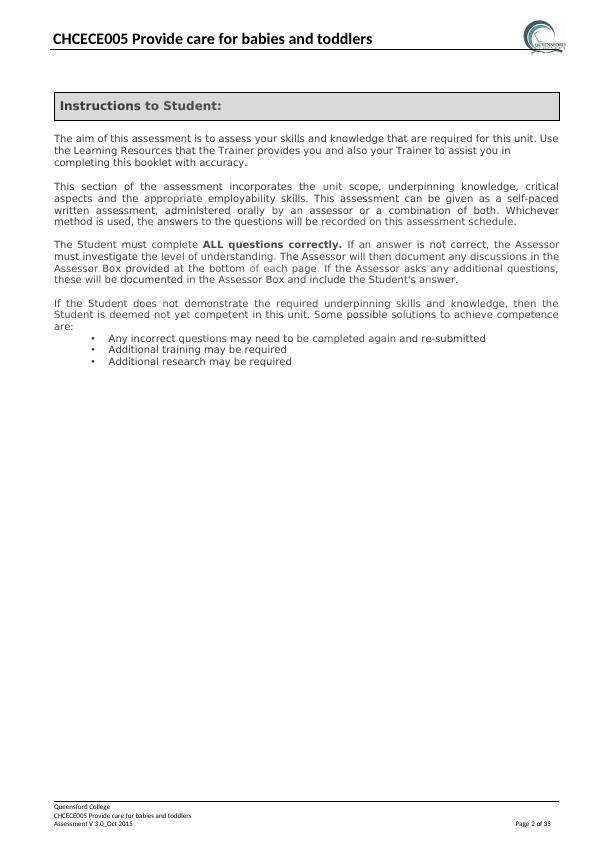
CHCECE005 Provide care for babies and toddlers
Knowledge Assessment
To be completed by the Student)
1. Read the statements below and indicate whether it is True or False.
Statement
Early brain development has a significant impact on learning and behaviour
as well as later physical and mental health.
True
Brain development is determined solely by our genes. False
Consistency of Educators supports string attachments which in turn supports
brain development.
True
Human interactions and sensory stimulation have a profound effect on how
the brain develops.
True
All children develop in the same way at the same time. False
Brain development is not directly influenced by culture. False
During critical and sensitive periods, specific areas of the brain grow and are
more active in response to sensory stimulation.
True
Positive early childhood experiences are likely to prevent or reduce the
likelihood of learning, social and emotional problems.
True
Rest and nutrition do not affect brain development. True
The provision of warm, nurturing and responsive relationships is essential to
healthy brain development.
True
Reading aloud to children helps stimulate brain development. True
2. List three strategies that Educators can use to encourage brain development through sensory
stimulation.
Sensory play is any activity that stimulates touch, smell, balance, taste, and hearing and sight
senses of a child. Through sensory stimulation, children are allowed to refine their thresholds
for sensory information that help brain to make stronger connections and responding to
sensory information (VanHoorn et al. 2014).
The strategies include:
Touch- warm water play, texture mats
Hear- listening outdoors, talking with other children
See- picture books, bubble watching
Taste- teething rings and bottles, sucking on food
Smell- Expose the baby to smell oils and lotions
Queensford College
CHCECE005 Provide care for babies and toddlers
Assessment V 3.0_Oct 2015 Page 3 of 35
Knowledge Assessment
To be completed by the Student)
1. Read the statements below and indicate whether it is True or False.
Statement
Early brain development has a significant impact on learning and behaviour
as well as later physical and mental health.
True
Brain development is determined solely by our genes. False
Consistency of Educators supports string attachments which in turn supports
brain development.
True
Human interactions and sensory stimulation have a profound effect on how
the brain develops.
True
All children develop in the same way at the same time. False
Brain development is not directly influenced by culture. False
During critical and sensitive periods, specific areas of the brain grow and are
more active in response to sensory stimulation.
True
Positive early childhood experiences are likely to prevent or reduce the
likelihood of learning, social and emotional problems.
True
Rest and nutrition do not affect brain development. True
The provision of warm, nurturing and responsive relationships is essential to
healthy brain development.
True
Reading aloud to children helps stimulate brain development. True
2. List three strategies that Educators can use to encourage brain development through sensory
stimulation.
Sensory play is any activity that stimulates touch, smell, balance, taste, and hearing and sight
senses of a child. Through sensory stimulation, children are allowed to refine their thresholds
for sensory information that help brain to make stronger connections and responding to
sensory information (VanHoorn et al. 2014).
The strategies include:
Touch- warm water play, texture mats
Hear- listening outdoors, talking with other children
See- picture books, bubble watching
Taste- teething rings and bottles, sucking on food
Smell- Expose the baby to smell oils and lotions
Queensford College
CHCECE005 Provide care for babies and toddlers
Assessment V 3.0_Oct 2015 Page 3 of 35

CHCECE005 Provide care for babies and toddlers
Assessor Notes:
3. How can Educators build healthy and secure attachments with the infants/toddlers in their care?
While caring for babies, many safety issues may arise and it is the caregiver’s
responsibility to protect the young infant. In care-giving practices, it is important for
educators to provide a safety environment that support and protect them. When educators
provide friendly environment to infants, they feel happy, contend, secured and safe with
them. When educators follow child’ routines, communicate with them, identify their cues in
a positive manner, this helps to build healthy and safe relationship with babies during care
activities.
4. Match the care descriptors to the three key components of nurturing care for infants and toddlers.
Please Note: Each descriptor may match more than one component of care.
Care Descriptors
Relationshi
ps
Physical
Environme
nt
Care
Routines
a. Educators respond to crying promptly and in ways that meet the
baby’s need.
Yes
b. Educators reinforce and praise infant/toddlers who attempts to
communicate.
Yes
c. Nappy change is used as a prime time for interactions between
Educators and infants/toddlers.
Yes
d. Educators ensure that there are peaceful, quiet places for infants and
toddlers to rest and relax.
Yes
e. Educators arrange equipment so there is easy access for toddlers. yes
f. Educators are sensitive to cues and ‘personal’ language of each
infant/toddler.
yes
Queensford College
CHCECE005 Provide care for babies and toddlers
Assessment V 3.0_Oct 2015 Page 4 of 35
Assessor Notes:
3. How can Educators build healthy and secure attachments with the infants/toddlers in their care?
While caring for babies, many safety issues may arise and it is the caregiver’s
responsibility to protect the young infant. In care-giving practices, it is important for
educators to provide a safety environment that support and protect them. When educators
provide friendly environment to infants, they feel happy, contend, secured and safe with
them. When educators follow child’ routines, communicate with them, identify their cues in
a positive manner, this helps to build healthy and safe relationship with babies during care
activities.
4. Match the care descriptors to the three key components of nurturing care for infants and toddlers.
Please Note: Each descriptor may match more than one component of care.
Care Descriptors
Relationshi
ps
Physical
Environme
nt
Care
Routines
a. Educators respond to crying promptly and in ways that meet the
baby’s need.
Yes
b. Educators reinforce and praise infant/toddlers who attempts to
communicate.
Yes
c. Nappy change is used as a prime time for interactions between
Educators and infants/toddlers.
Yes
d. Educators ensure that there are peaceful, quiet places for infants and
toddlers to rest and relax.
Yes
e. Educators arrange equipment so there is easy access for toddlers. yes
f. Educators are sensitive to cues and ‘personal’ language of each
infant/toddler.
yes
Queensford College
CHCECE005 Provide care for babies and toddlers
Assessment V 3.0_Oct 2015 Page 4 of 35
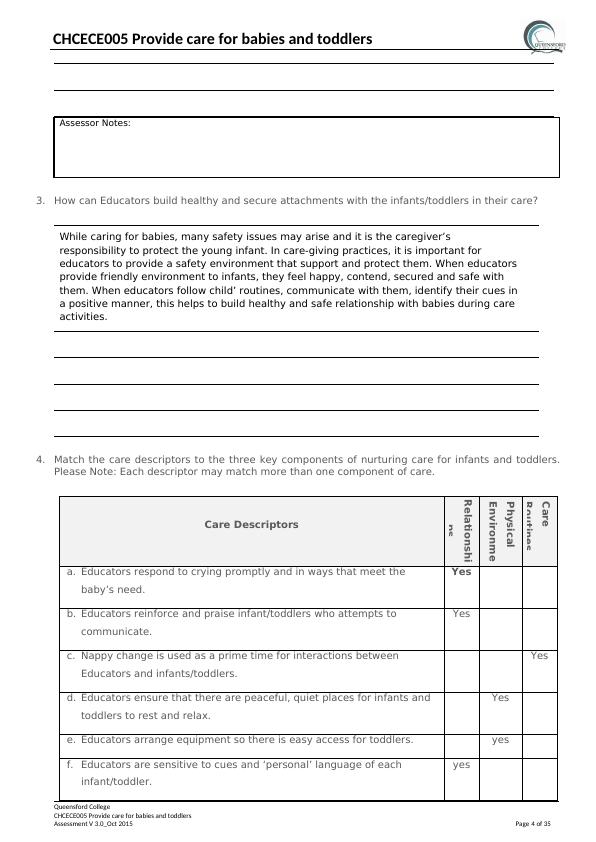
CHCECE005 Provide care for babies and toddlers
g. Educators get down to the children’s level so that it is possible to be
face-to-face and have eye contact.
yes
h. Educators are aware of each infant/toddler’s comforter such as a
dummy, toy or special blanket.
yes
i. Educators look for and respond to infant/toddlers attempts at non-
verbal as well as verbal communication.
yes
Assessor Notes:
5. Read each Educator practice and:
i. Indicate whether or not the practice helps to build a respectful and trusting
relationship with infants and toddlers.
ii. Provide a reason for your response.
Think about quality care practices such as:
Continuity of care.
Respect for children and families.
Acknowledgement of diversity.
Promoting self-regulation and empathy.
Toddlers are hands-on learners.
Recognising individual needs/differences.
Importance of quality interactions.
Practice Supportiv
e?
Reason
Yes No
Educators rotate from the
infant/toddler rooms to the
preschool rooms every 4 – 6
months.
Yes Rotation of teachers is must as if individuals
resign temporarily or permanently, there is no
shutdown of daycares. This can greatly
hamper the consumer services if preschools
have personnel turnover.
All 15 toddlers are required to sit
and listen quietly to the Educator
read stories for around 20
minutes.
No Working with a big group is not convenient, as
the children should be allowed to develop their
own oral skills and language development.
Making the toddlers sit for 20 minutes is not
good, as they should be allowed to sit for only
Queensford College
CHCECE005 Provide care for babies and toddlers
Assessment V 3.0_Oct 2015 Page 5 of 35
g. Educators get down to the children’s level so that it is possible to be
face-to-face and have eye contact.
yes
h. Educators are aware of each infant/toddler’s comforter such as a
dummy, toy or special blanket.
yes
i. Educators look for and respond to infant/toddlers attempts at non-
verbal as well as verbal communication.
yes
Assessor Notes:
5. Read each Educator practice and:
i. Indicate whether or not the practice helps to build a respectful and trusting
relationship with infants and toddlers.
ii. Provide a reason for your response.
Think about quality care practices such as:
Continuity of care.
Respect for children and families.
Acknowledgement of diversity.
Promoting self-regulation and empathy.
Toddlers are hands-on learners.
Recognising individual needs/differences.
Importance of quality interactions.
Practice Supportiv
e?
Reason
Yes No
Educators rotate from the
infant/toddler rooms to the
preschool rooms every 4 – 6
months.
Yes Rotation of teachers is must as if individuals
resign temporarily or permanently, there is no
shutdown of daycares. This can greatly
hamper the consumer services if preschools
have personnel turnover.
All 15 toddlers are required to sit
and listen quietly to the Educator
read stories for around 20
minutes.
No Working with a big group is not convenient, as
the children should be allowed to develop their
own oral skills and language development.
Making the toddlers sit for 20 minutes is not
good, as they should be allowed to sit for only
Queensford College
CHCECE005 Provide care for babies and toddlers
Assessment V 3.0_Oct 2015 Page 5 of 35
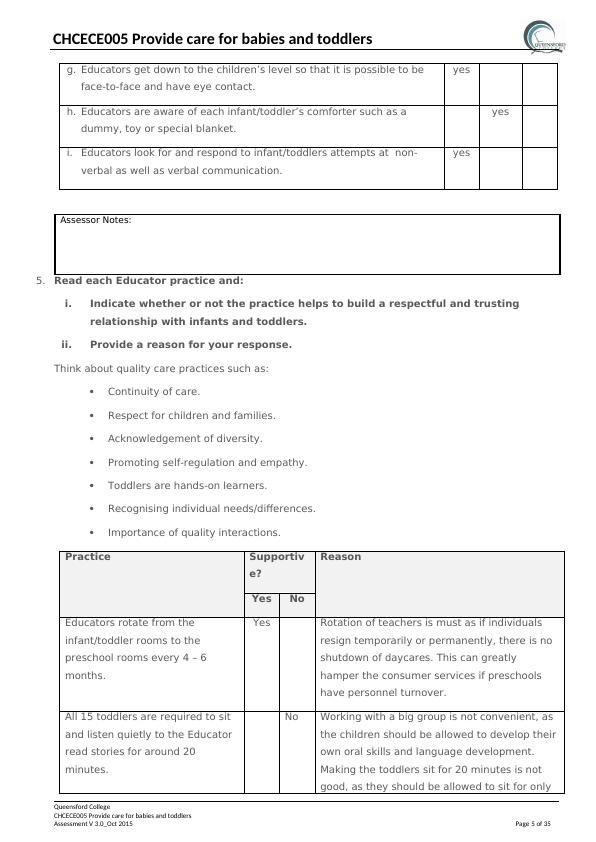
CHCECE005 Provide care for babies and toddlers
10 minutes and attend to their behaviour.
Educators always try to assist
toddlers to see the consequences
of their actions in a respectful
manner. E.g. Look at Callie, she’s
crying. Can you give her a hug?
Yes This example is supportive as through this
example it is quite convenient that educators
are teaching the child that if someone gets
hurt and starts crying, one should hug him or
her so that one feel better and stops crying.
Every child has their own space to
put their personal belongings.
Yes This will make children feel safe and secure
where they can keep their belongings safely.
Educators use threats to gain
toddlers cooperation. If you don’t
pick up those blocks you can’t go
outside!
No Threatening dos not lead to cooperation as it
leads to arguments, power struggles and
greatly discourage children.
Educators require all
infants/toddlers to follow the
same sleep routine.
No Sleep routine are different for every infant and
educators should provide a safe and
comforting environment for it that ensures a
calming sleeping environment.
Educator focuses most of their
time on writing programs and
documenting observations, and
spends little time interacting with
infants/toddlers.
No Important and intimate relationships are
formed when educators interact with them
through activities like observing and
supporting play.
The program at Blue Bay Early
Learning Centre reflects the rich
cultural diversity of the local and
broader community.
yes Through this program, the learning centre is
showing respect for the community by
displaying trust and respect for the broader
community.
Queensford College
CHCECE005 Provide care for babies and toddlers
Assessment V 3.0_Oct 2015 Page 6 of 35
10 minutes and attend to their behaviour.
Educators always try to assist
toddlers to see the consequences
of their actions in a respectful
manner. E.g. Look at Callie, she’s
crying. Can you give her a hug?
Yes This example is supportive as through this
example it is quite convenient that educators
are teaching the child that if someone gets
hurt and starts crying, one should hug him or
her so that one feel better and stops crying.
Every child has their own space to
put their personal belongings.
Yes This will make children feel safe and secure
where they can keep their belongings safely.
Educators use threats to gain
toddlers cooperation. If you don’t
pick up those blocks you can’t go
outside!
No Threatening dos not lead to cooperation as it
leads to arguments, power struggles and
greatly discourage children.
Educators require all
infants/toddlers to follow the
same sleep routine.
No Sleep routine are different for every infant and
educators should provide a safe and
comforting environment for it that ensures a
calming sleeping environment.
Educator focuses most of their
time on writing programs and
documenting observations, and
spends little time interacting with
infants/toddlers.
No Important and intimate relationships are
formed when educators interact with them
through activities like observing and
supporting play.
The program at Blue Bay Early
Learning Centre reflects the rich
cultural diversity of the local and
broader community.
yes Through this program, the learning centre is
showing respect for the community by
displaying trust and respect for the broader
community.
Queensford College
CHCECE005 Provide care for babies and toddlers
Assessment V 3.0_Oct 2015 Page 6 of 35
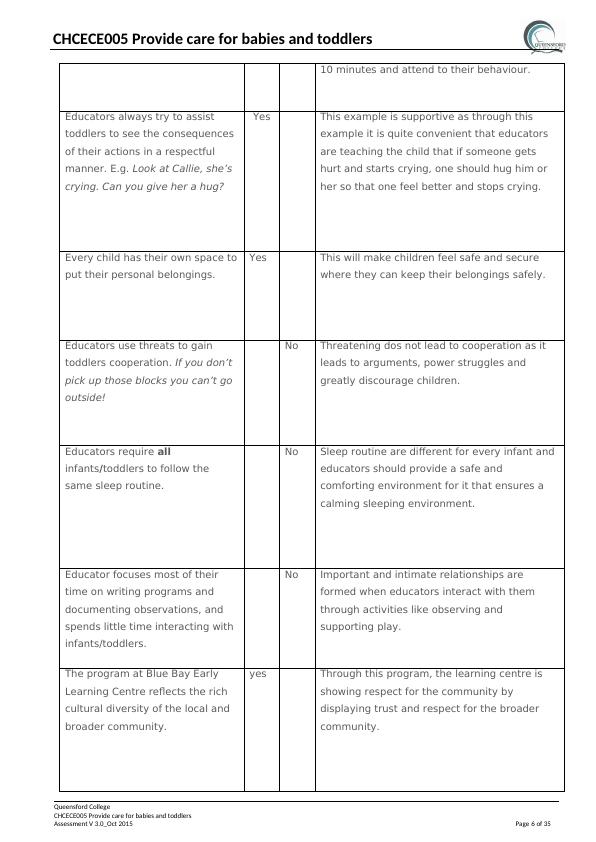
CHCECE005 Provide care for babies and toddlers
6. What does Element 2.1.2 of the NQS aim to achieve?
National Quality Framework, Quality Area 2 aims to safeguard and promote health and safety
among children with minimization of risks and protecting children from infection, injury and
harm. Every child has a right to experience care and quality education that promotes its
psychological and physical wellbeing. This quality area supports the growth competence,
independence and competence among the children. The element 2.1.2 if the NQF aims to
promote hygiene practices, effective injury and illness management for the children healthy
and safety. The aim is to inculcate health procedures and practices among the children.
In the given case scenario, educator promoted a safe and healthy environment for the child
through encouraging him to practice hand hygiene by modifying the environment for him so
that he is independent in performing it (Tayler et al. 2013).
7. Scenario
Molly
Practice: The Educator recognises and accommodates the specific sleep/rest patterns of babies and
toddlers.
Molly’s parents informed the Educator, Sue, that when she is tired she rubs her eyes and cries.
When she is settling for a sleep, Molly (6 months) likes to hold the satin edge of a baby blanket.
After lunch time Sue notices Molly is restless and rubbing her eyes. She picks Molly up and says,
“Are you sleepy Molly?” Molly snuggles into Sue’s shoulder. As Sue changes Molly’s nappy, she
talks softly to her. Sue sits on the lounge with Molly in her lap and gives Molly her bottle. Molly
holds the bottle and Sue sings Molly’s favourite song.
When Molly has finished her bottle she is looking drowsy. Sue places Molly in the cot with her satin
edge blanket. Sue stays with Molly until she is asleep.
Assessor Notes:
a. In the scenario ‘Molly’, how has the Educator demonstrated quality care practices?
After getting to know about Molly sleeping patterns, facial expression and body movements,
Sue responded to her through responsive and warm care while communicating with warm
words. This inculcates sense of comfort and trust through a nurturing baby-caregiver
relationship. The secured attachment help to give a safe and sensitive environment to the
babies providing feeling of safety through activities like feeding, nappy change and singing
Queensford College
CHCECE005 Provide care for babies and toddlers
Assessment V 3.0_Oct 2015 Page 7 of 35
6. What does Element 2.1.2 of the NQS aim to achieve?
National Quality Framework, Quality Area 2 aims to safeguard and promote health and safety
among children with minimization of risks and protecting children from infection, injury and
harm. Every child has a right to experience care and quality education that promotes its
psychological and physical wellbeing. This quality area supports the growth competence,
independence and competence among the children. The element 2.1.2 if the NQF aims to
promote hygiene practices, effective injury and illness management for the children healthy
and safety. The aim is to inculcate health procedures and practices among the children.
In the given case scenario, educator promoted a safe and healthy environment for the child
through encouraging him to practice hand hygiene by modifying the environment for him so
that he is independent in performing it (Tayler et al. 2013).
7. Scenario
Molly
Practice: The Educator recognises and accommodates the specific sleep/rest patterns of babies and
toddlers.
Molly’s parents informed the Educator, Sue, that when she is tired she rubs her eyes and cries.
When she is settling for a sleep, Molly (6 months) likes to hold the satin edge of a baby blanket.
After lunch time Sue notices Molly is restless and rubbing her eyes. She picks Molly up and says,
“Are you sleepy Molly?” Molly snuggles into Sue’s shoulder. As Sue changes Molly’s nappy, she
talks softly to her. Sue sits on the lounge with Molly in her lap and gives Molly her bottle. Molly
holds the bottle and Sue sings Molly’s favourite song.
When Molly has finished her bottle she is looking drowsy. Sue places Molly in the cot with her satin
edge blanket. Sue stays with Molly until she is asleep.
Assessor Notes:
a. In the scenario ‘Molly’, how has the Educator demonstrated quality care practices?
After getting to know about Molly sleeping patterns, facial expression and body movements,
Sue responded to her through responsive and warm care while communicating with warm
words. This inculcates sense of comfort and trust through a nurturing baby-caregiver
relationship. The secured attachment help to give a safe and sensitive environment to the
babies providing feeling of safety through activities like feeding, nappy change and singing
Queensford College
CHCECE005 Provide care for babies and toddlers
Assessment V 3.0_Oct 2015 Page 7 of 35
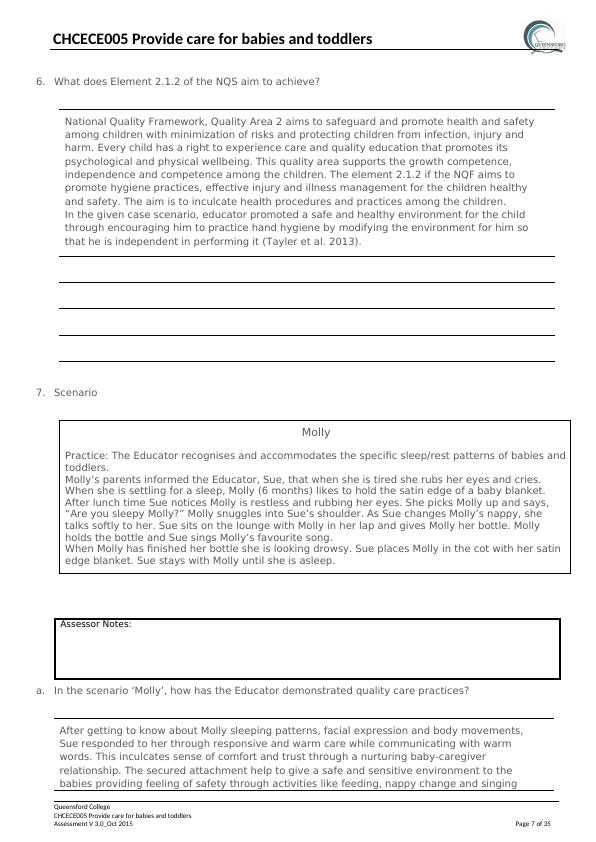
CHCECE005 Provide care for babies and toddlers
favourite song of Molly and staying until she sleeps.
A warm and emotional climate between Molly and educator helped her to explore the
surrounding world and learn from her experiences by staying close to her, singing through
calming voice, matched effect and respectful language (Mindell and Owens 2015).
8. Scenario
Sara
Sara (9 months) has been in care for two months. Whenever she is placed in a cot she begins
screaming. She pulls herself to a standing position and sometimes flings herself backwards,
arching her back as she screams.
a. In the scenario ‘Sara’ identify Sara’s needs and how she might be feeling?
Babies sleep in various ways; some babies like to sleep on beds, mats or hammocks. In the
scenario, it is evident that Sara feels uncomfortable to sleep in cot. Therefore, it is
important to provide a sleep friendly environment to Sara so that she could try to get
accustomed to new circumstances and encounters.
b. Identify how the Educator can involve Sara’s family in meeting her sleep needs.
After getting information about Sara’s sleep patterns from her parents, educator plan for
her sleeping needs. There are several ways to provide an adapting room to Sara at home.
Te educator needs to find out the way Sara sleeps at home. Patting, rocking the bed,
rubbing back and help the baby to explore the surrounding world on her own can help her
to sleep well. The educator should know the bed routine of Sara and use comforters like soft
toys or blanket during her sleep. Gently responding to Sara’s routine can be helpful in
meeting her sleeping needs.
9. Scenario
Ben
Practice: Educators are sensitive to toddlers emerging skills and plan an environment that is
predictable and allows children to practise their new skills.
Queensford College
CHCECE005 Provide care for babies and toddlers
Assessment V 3.0_Oct 2015 Page 8 of 35
favourite song of Molly and staying until she sleeps.
A warm and emotional climate between Molly and educator helped her to explore the
surrounding world and learn from her experiences by staying close to her, singing through
calming voice, matched effect and respectful language (Mindell and Owens 2015).
8. Scenario
Sara
Sara (9 months) has been in care for two months. Whenever she is placed in a cot she begins
screaming. She pulls herself to a standing position and sometimes flings herself backwards,
arching her back as she screams.
a. In the scenario ‘Sara’ identify Sara’s needs and how she might be feeling?
Babies sleep in various ways; some babies like to sleep on beds, mats or hammocks. In the
scenario, it is evident that Sara feels uncomfortable to sleep in cot. Therefore, it is
important to provide a sleep friendly environment to Sara so that she could try to get
accustomed to new circumstances and encounters.
b. Identify how the Educator can involve Sara’s family in meeting her sleep needs.
After getting information about Sara’s sleep patterns from her parents, educator plan for
her sleeping needs. There are several ways to provide an adapting room to Sara at home.
Te educator needs to find out the way Sara sleeps at home. Patting, rocking the bed,
rubbing back and help the baby to explore the surrounding world on her own can help her
to sleep well. The educator should know the bed routine of Sara and use comforters like soft
toys or blanket during her sleep. Gently responding to Sara’s routine can be helpful in
meeting her sleeping needs.
9. Scenario
Ben
Practice: Educators are sensitive to toddlers emerging skills and plan an environment that is
predictable and allows children to practise their new skills.
Queensford College
CHCECE005 Provide care for babies and toddlers
Assessment V 3.0_Oct 2015 Page 8 of 35
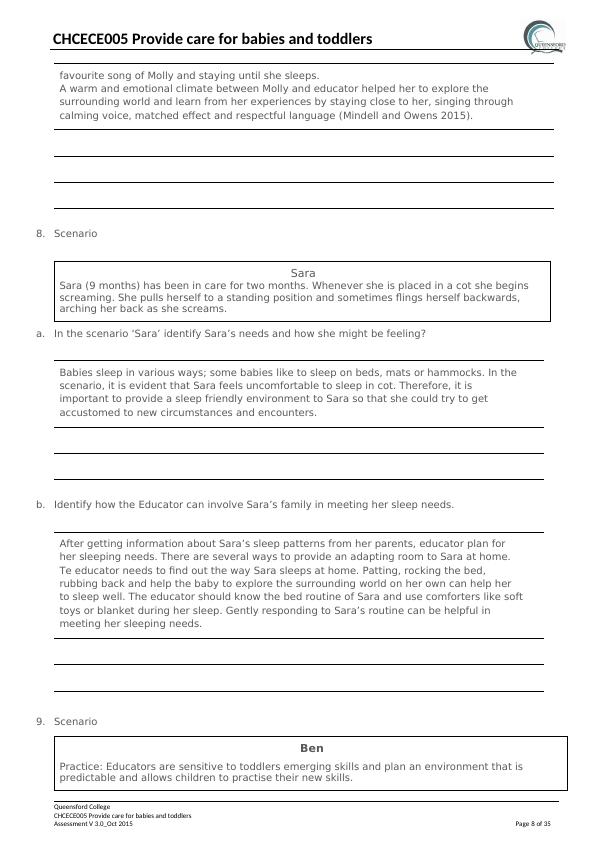
End of preview
Want to access all the pages? Upload your documents or become a member.
Related Documents
CHCECE007 Develop positive and respectful relationships with childrenlg...
|41
|15505
|164
CHCECE024 Design and Implement the Curriculum to Foster Children’s Learning and Developmentlg...
|18
|7257
|104
CHCECE020 Establish and Implement Plans for Developing Cooperative Behaviourlg...
|51
|16198
|233
BSBLED401 Develop teams and individuals Knowledge Assessmentlg...
|28
|11468
|483
CHCECE019 Facilitate compliance in an education and care servicelg...
|21
|4066
|285
CHCECE025 Embed Sustainable Practices in Service Operationslg...
|20
|4498
|435
